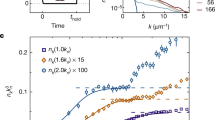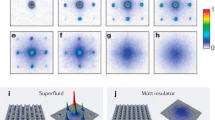
Overview
- Nominated as an outstanding Ph.D. theses by Kyoto University, Kyoto, Japan
- Presents a field theoretical calculation of quantum and thermal fluctuation effects on the stability of the Higgs mode of strongly correlated Bose gases in a three-dimensional optical lattice
- Demonstrates that the truncated-Wigner approximation quantitatively reproduces non-equilibrium dynamics of interacting bosons observed in a cold-atomic quantum simulator in three dimensions
Part of the book series: Springer Theses (Springer Theses)
Access this book
Tax calculation will be finalised at checkout
Other ways to access
About this book
This book discusses non-equilibrium quantum many-body dynamics, recently explored in an analog quantum simulator of strongly correlated ultracold atoms. The first part presents a field-theoretical analysis of the experimental observability of the Higgs amplitude mode that emerges as a relativistic collective excitation near a quantum phase transition of superfluid Bose gases in an optical lattice potential. The author presents the dynamical susceptibilities to external driving of the microscopic parameters, taking into account a leading-order perturbative correction from quantum and thermal fluctuations and shows clear signatures of the Higgs mode in these observables. This is the first result that strongly supports the stability of the Higgs mode in three-dimensional optical lattices even in the presence of a spatially inhomogeneous confinement potential and paves the way for desktop observations of the Higgs mode.
In the second part, the author applies the semi-classical truncated-Wigner approximation (TWA) to far-from-equilibrium quantum dynamics. Specifically, he considers the recent experiments on quantum-quench dynamics in a Bose-Hubbard quantum simulator. A direct comparison shows remarkable agreement between the numerical results from TWA and the experimental data. This result clearly indicates the potential of such a semi-classical approach in reliably simulating many-body systems using classical computers.
The book also includes several chapters providing comprehensive reviews of the recent studies on cold-atomic quantum simulation and various theoretical methods, including the Schwinger-boson approach in strongly correlated systems and the phase-space semi-classical method for far-from-equilibrium quantum dynamics. These chapters are highly recommended to students and young researchers who are interested in semi-classical approaches in non-equilibrium quantum dynamics.
Similar content being viewed by others
Keywords
- Strongly Correlated Ultracold Atoms in Optical Latices
- Quantum Simulation of Strongly Correlated Systems
- Superfluid-Mott-Insulator Transition of Correlated Bosons
- Dynamical Response of Higgs Mode
- Non-equilibrium Dynamics of Correlated Bosons in Optical Lattice
- Semiclassical Approximation for Analysis of Quench Dynamics
- Truncated Wigner Approximation
- Wigner Representation of Bose Fields
Table of contents (6 chapters)
Authors and Affiliations
About the author
Bibliographic Information
Book Title: Fluctuations and Non-Equilibrium Phenomena in Strongly-Correlated Ultracold Atoms
Authors: Kazuma Nagao
Series Title: Springer Theses
DOI: https://doi.org/10.1007/978-981-15-7171-8
Publisher: Springer Singapore
eBook Packages: Physics and Astronomy, Physics and Astronomy (R0)
Copyright Information: The Editor(s) (if applicable) and The Author(s), under exclusive license to Springer Nature Singapore Pte Ltd. 2020
Hardcover ISBN: 978-981-15-7170-1Published: 26 August 2020
Softcover ISBN: 978-981-15-7173-2Published: 26 August 2021
eBook ISBN: 978-981-15-7171-8Published: 25 August 2020
Series ISSN: 2190-5053
Series E-ISSN: 2190-5061
Edition Number: 1
Number of Pages: XIX, 112
Number of Illustrations: 18 b/w illustrations, 18 illustrations in colour
Topics: Quantum Gases and Condensates, Strongly Correlated Systems, Superconductivity, Phase Transitions and Multiphase Systems, Statistical Physics and Dynamical Systems



